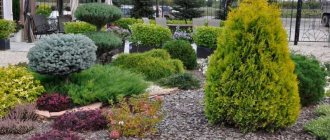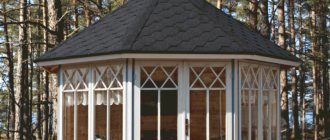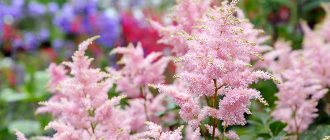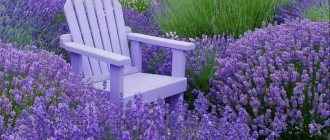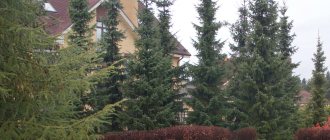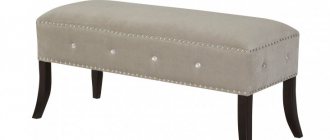Features of plants for decoration
Grasses from several genera are considered ornamental - Grassaceae, Cataceae, Ruminaceae and Sedgeaceae. In total, there are at least 10,000 herbs used in landscape design in the world. They are valued for their elegant spikelets, which have a special sound when the wind blows.
Both annuals and perennials have their rightful place. A wide selection of options will help to decorate any garden in an unusual way and make it unique in any month of the year. For example, in the spring they will delight the eyes with lush greenery, in the summer they will have beautiful panicles.
In the fall, different varieties of grass can paint the area in different colors, and in the winter, some types will also add charm.
Tall ornamental grasses for the garden
Ornamental cereal crops whose height exceeds one meter are classified as tall plants. They are used both as a background in multi-level compositions and to create floral screens. The tall ones include reed grass, pennisetum glaucosa, pearl barley, sugar-flowered miscanthus, and reed falaris (Figure 7).
Note: When starting planting, it is advisable to familiarize yourself with the plant’s soil requirements: does it need sufficient moisture or can it easily tolerate drought. Depending on the needs, a specific area is selected. The situation is the same with planting itself, because its conditions should be considered for each species separately. However, there are some general conditions of agricultural technology that can be applied to different species.
Having chosen a site, we begin to prepare the soil. It must be dug up, freeing it from remnants of weed roots, and leveled. Planting holes are made on a flat surface corresponding to the size of the root system of the seedling. These holes must be well moistened, and only after the moisture has been absorbed can planting begin. Most ornamental grasses need to be planted shallow. The roots are sprinkled with damp soil, and the soil itself is compacted and carefully watered. After planting the plant, you can also resort to mulching, that is, covering the soil with organic material to retain moisture longer. Some gardeners advise lightly shading the seedling in the first days after planting.
Figure 7. Tall ornamental plants for the garden: 1 - acute-flowered broom, 2 - gray pennisetum, 3 - sugar-flowered miscanthus
Further care is not particularly difficult. So, if the plant was planted in summer, it is necessary to water it regularly for better survival; Herbs planted in spring and autumn, as a rule, take root easily and without additional watering. It is important to know that after heavy rains or heavy watering, the soil under the plantings should be loosened to avoid the formation of a soil crust. In parallel with loosening, weeding is carried out, removing weeds. It is not recommended to fertilize ornamental grasses during the year of planting. In preparation for winter, place cut branches of shrubs in the flower beds so that fallen snow can linger on them, forming a shelter for ornamental plants. With the arrival of spring, trim the leaves of the grass and loosen the soil for the first time.
Medium-sized species
Ornamental grasses with a height of 50 cm to 1 meter are called medium-sized. Basically, they are used to design mixborders and form multi-tiered flower beds. Among the medium-sized grasses, the most popular are feather grass, oats, pinnate bristle grass, imperata, falaris, sesleria (Figure 8).
When choosing a site for planting, you should find out as much as possible about the species you have chosen, clarify the growing conditions and care features. For example, falaris prefers soil rich in moisture, while imperata cylindrical does not tolerate its excess.
Figure 8. Types of medium-sized ornamental grasses for the garden: 1 - feather grass, 2 - sesleria, 3 - falaris
Having determined the location, you can begin preparing the soil. It must be dug up, removing the rhizomes of perennial weeds, and leveled. Then you need to designate the probable places of growth of all elements of the flowerbed, taking into account the size of adult bushes. Seedlings of ornamental grasses are planted in the planting holes, the soil around them is watered and compacted. Further care consists of watering as needed, loosening the soil and weed control, spring pruning and covering for the winter.
Low-growing species
The height of low-growing ornamental grasses does not exceed 50 cm. Therefore, they are actively used in small gardens, where they take up very little space. Using low-growing ornamental grasses, you can decorate flower beds and areas with poor vegetation (Figure 9).
Note: The advantage of this type of ornamental plants is that they can, on the one hand, be used to create individual compositions, and on the other hand, serve as a wonderful background for other garden plants. Prominent representatives of low-growing grasses are common heather, maned barley, haretail, and blue fescue.
Figure 9. Low grasses for decorating the garden: 1 - heather, 2 - haretail, 3 - maned barley
When starting to plant low-growing grasses, try to learn more about their characteristics: what kind of soil they prefer, what time of year their active period of growth falls. Remember that you cannot add fertilizer to the soil before planting perennial ornamental grasses, as this leads to their too active growth and loss of shape in the future. The seedling must be watered abundantly after planting. Regularly loosen the soil and weed. In early spring, last year's leaves and dry shoots should be trimmed, and some plants should be additionally covered for the winter. The only problem with care may be the excessive encroachment of territories by some types of ornamental grasses, so measures should be taken to limit where they grow.
Kaleria gray
It is recommended to provide it with dry soil mixed with sand. It does not feel very comfortable in damp conditions, so drainage during sowing is very desirable. This is a perennial representative of Cereals that can reproduce by seeds and division.
It is not afraid of wintering, and the height of the leaves reaches 15 cm. You can use it as part of an alpine hill or sow it alone.
What are the features and decorative properties of cereals
In general, grasses in landscape design do not have distinct colors. Cereal flowers are panicles, plumes and spikes that can have a bright and lush appearance, but more often they look quite modest. Their strength lies in originality and charm, coupled with the unpretentiousness of the majority. It is these combinations of properties that increasingly attract landscape designers to them. Inspires them to come up with ideas to create a grain garden in their landscape.
The wide distribution of cereals will help you choose the right plant for any point in the landscape:
- on the lawn;
- cereals in the flowerbed;
- in the park in the shade of trees;
- in the lowlands;
- on an alpine hill;
- near a pond.
A specimen will always be selected for which the soil quality, climate and lighting will be the best.
Before buying seeds, you need to study the preferences of plants and select those that will take root in your garden.
Consider the decorative period. Some (miscanthus, imperata, switchgrass) begin to grow in early spring; by summer they slow down and bloom by early autumn.
Others (foxtail, reed grass, sedge) are picturesque in early summer, and retain panicles even in winter.
Moisture-loving cereals (fox sedge, reed, cattail) feel great in acidic, waterlogged soil or near an artificial pond. And such as imperata, gray fescue, and sandy grate will withstand drought without losing their beauty.
Field fescue
Perfect for dry summer conditions. One sowing can be grown for up to 4 years, after which it is uprooted and sown “from scratch”, because the plants lose their appearance and degenerate.
To renew, you can cut fresh spikelets and throw them from below. After new blades of grass grow from them, they are replanted, and the old bushes are completely removed.
Caring for ornamental grasses
Despite the unpretentiousness of most perennials for the garden, experienced gardeners still recommend providing some care to the plants. To do this, you can use several techniques to preserve ornamental grasses on your site:
- To preserve the attractive appearance and decorative properties of cereal crops for a long time, the inflorescences must be cut off after wilting.
- After spring pruning, you can feed the lawn and the area for planting ornamental grasses and grains with mulch. To do this, mix sand and peat in equal proportions.
- In early spring, immediately after the opening of greenhouses on ornamental vegetation, it is necessary to cut off last year's foliage and stems. This way, perennial varieties will develop better. The crown of the plant will become more luxuriant.
In addition to simple maintenance, it is necessary to monitor soil moisture. It is important not to overdo it with watering, since ornamental grasses and grains for the garden do not tolerate an excess of water, as a result of which the root system begins to rot.
Miscanthus chinensis
This is one of the favorite cereal plants for decorating a personal plot.
This perennial can reach a height of 1.5 meters. Its leaves are narrow and have white stripes along the edges. Outwardly, it somewhat resembles a fountain formed by leaves. Flowering is observed at the end of summer in the form of red panicles, which gradually turn brown. When planting in autumn, it is advisable to insulate it for the winter. There are no special requirements for the soil.
Common varieties and features
Ornamental grass for the garden has perennial and annual varieties. They also differ in height; there are low-growing grasses (0.3 - 0.5 meters), medium-sized ones from half a meter to 1 m, and tall ones - up to 200 cm and above.
Maned barley
Maned barley forms dense, picturesque bushes and is used mainly for borders. This is a perennial crop, but it does not withstand severe frosts, and in some climate zones it is necessary to sow annually.
haretail
Haretail is one of the few cereals designed to be grown in partial shade. Its green leaves with a silver tint and fluffy inflorescences combine well with bright flowers. An interesting effect is obtained in mixed flower-cereal beds.
Perlovnik ciliated
It has light green leaves. It blooms in early summer with white flowers for a month. Spreads by seeds.
Blue fescue
Blue fescue is a frost-resistant grass. The original bluish color of this cereal in combination with needle-shaped leaves creates an irresistible airy effect.
It looks good on borders and in flower and stone arrangements, but it needs sun to look beautiful.
Field fescue
Perfect for dry summer conditions. One sowing can be grown for up to 4 years, after which it is uprooted and sown “from scratch”, because the plants lose their appearance and degenerate.
To renew, you can cut fresh spikelets and throw them from below. After new blades of grass grow from them, they are replanted, and the old bushes are completely removed.
Hairy cirrus bristle
Hairy pinnate bristle is a perennial with white, pink or purple panicles and ribbon-like leaves. This is another heat-loving plant, which is grown as an annual plant in the middle zone. Can be used in alpine slides and rocky gardens.
Kaleria gray
It is recommended to provide it with dry soil mixed with sand. It does not feel very comfortable in damp conditions, so drainage during sowing is very desirable. This is a perennial representative of Cereals that can reproduce by seeds and division.
It is not afraid of wintering, and the height of the leaves reaches 15 cm. You can use it as part of an alpine hill or sow it alone.
Kolosnyak
It will look good as a single bush or as a border. Goes well with lilies. It is painted gray and retains its shape well. The disadvantage is its rapid growth, which can be combated by fencing the grass with slate or planting it in a container without a bottom.
Decorative millet
This is an annual that has beautiful leaves that are purple-brown in color and wide. Small shoots are green with a purple border. The grown plant looks like a reed.
An unusual inflorescence appears in mid-summer, and by August white specks of dust appear on it. Looks great until the first frost.
Miscanthus chinensis
This is one of the favorite cereal plants for decorating a personal plot. This perennial can reach a height of 1.5 meters. Its leaves are narrow and have white stripes along the edges. Outwardly, it somewhat resembles a fountain formed by leaves.
Interesting: Secrets of the correct selection of plants for mixborders, diagrams
Flowering is observed at the end of summer in the form of red panicles, which gradually turn brown. When planting in autumn, it is advisable to insulate it for the winter. There are no special requirements for the soil.
Mace Bearer
The dense, seemingly bristling bushes of the gray macebearer are ideal for decorating borders 20-30 cm high. This light-loving and fast-growing ground cover plant takes root well in sandy soils of the middle zone.
Ophiopogon Nigrescens
A favorite of exotic lovers, Ophiopogon Nigrescens, a grass with black leaves, pink flowers and blue-black berries, can be a spectacular addition to exotic lawns, rockeries and alpine slides.
No less picturesque is the ophiopogon variety called Japanese with bright blue berries. This plant does not need winter shelter, is not afraid of temperature changes and wind, but requires maintaining air humidity and regular watering.
Lightning blue
Blue lightning is another tall grass with glaucous leaves and blue-violet panicles. It also needs moisture, planted together with flowers with a similar growth regime, or decorates the edges of artificial ponds.
The Miscanthus family deserves special attention. These giant-sized cereals with an erect stem have many varieties that differ in color and shape. This light-loving and moisture-loving plant, with a height of 80 cm to 3 m, needs protection from frost.
Used in mixborders, for decorating ponds, luxurious bushes of Chinese and sucrose miscanthus can become an exquisite decoration of green lawns.
Feather grass fluffy cloud
Feather grass fluffy cloud is a steppe unpretentious plant that, when growing, turns into original silky bushes; during flowering, the tips of the bush become pink or golden.
Another unusually beautiful variety of cultivated feather grass, “the most beautiful,” has the thinnest stems covered with transparent fluff.
Fox's tail
Foxtail (or short-haired reed grass) is a bright ornamental grass with downward curved stems that needs regular watering. It is fashionable to grow in both sun and partial shade. It can reach a height of more than a meter, needs watering and is used in the design of multi-level flower beds.
Wild oats
Wild oats, or Hasmantium latifolia, also grow to a height of up to a meter with sufficient sun and moisture. The main difference between the botanical species is the flat, regularly shaped inflorescences hanging on a thin stem.
Kolosnyak
It will look good as a single bush or as a border. Goes well with lilies. It is painted gray and retains its shape well. The disadvantage is its rapid growth, which can be combated by fencing the grass with slate or planting it in a container without a bottom.
Herbs and cereals for the site
Cereals are incredibly decorative plants, as their varied colors allow you to create an extraordinary design. Bluish plants with bright red herbs look beautiful, and purple grasses look good with silvery-yellow leaves. Cereal vegetation is an excellent partner for many garden flowers. They complement their majesty with elegance and lightness.
Low-growing varieties for use in the landscape of a summer cottage
The height of low-growing crops is up to half a meter. They are indispensable when designing decorative areas and separating garden paths. They occupy a place of honor in flower beds with boulders and are frequent guests in alpine hills and rockeries. Imitate the natural landscape.
- golden lamarckia
- tortuous meadow grass
- ovate haretail
- fescue
- gray cellar
Ovate haretail
Cereals for the garden of medium-sized varieties
The height of medium-sized crops is from 50 cm. They look advantageous if they grow in groups. Bright panicles create a flowerbed of continuous flowering. They look optimal when planted by whole families in the garden. Use to create multi-tiered compositions:
- Muhlenbergia hairy
- feather grass
- maned barley
- imperata cylindrical
- cirruschaete
Imperata cylindrical in the background
Tall varieties for landscape design
These varieties reach a height of 90 cm. They are used in multi-level compositions as a background. If planted in a row, they will perfectly serve as a screen or screen, hiding a recreation area or utility room from view. Representatives of tall varieties
- cortaderia
- reed grass
- miscanthus
- high pearl barley
- broadleaf flatgrass
Miscanthus
One of the main trends in garden design is the ease of caring for plants. The key task of a gardener is to competently select and plant herbs and grains. And further care becomes practically minimal. The vegetation itself grows, gradually filling the space left for it and blooms in its own time. Cereals are indispensable in landscape design when designing artificial reservoirs.
Decorative millet
This is an annual that has beautiful leaves that are purple-brown in color and wide. Small shoots are green with a purple border. The grown plant looks like a reed.
An unusual inflorescence appears in mid-summer, and by August white specks of dust appear on it. Looks great until the first frost.
Shade-tolerant ornamental grasses and grasses
Some crops will thrive in areas with little shade.
Spreading boron
It forms a fairly lush curtain up to 1 meter in height. It is distinguished by oblong leaves with a golden tint.
Bor Spreading
Inflorescences are greenish. Flowering begins in May and continues until June.
Hakonechloa major
It forms fairly dense thickets based on narrow linear leaves in yellowish-green shades.
Hakonechloa large in the rock garden
The culture tolerates shade well, but can also grow in the sun. Excellent for forming high borders next to paths.
Short-haired reed grass
It has erect stems on which silvery panicles are located. Height – up to 1.5 meters.
Photos of Veynik
Used in garden zoning, decorating background walls, creating mixborders.
It is also worth paying attention to the ovate haretail. Its main advantage is its spike-shaped inflorescences, which visually resemble a hare's tail. The height of the peduncles is up to 60 centimeters. The plant is not afraid of frost. Another advantage is the preparation of original dry bouquets from inflorescences.
Feather grass
An undemanding grass characterized by a disheveled “mane.” It does not clog the soil underneath, does not have creeping roots and, if necessary, can easily be pulled out of the ground. For 2-3 years you don’t have to worry about the beauty of the garden bed, but then it is recommended to replant it.
How to grow
It is easy to get confused among the many names of ornamental grass.
However, you need to know for sure whether it is suitable for your climatic conditions. They may need to be covered for the winter. After all, many species were brought from tropical and subtropical countries, where winters are much warmer than in the central zone, and even more so to the north. Usually all the required information is written on the packaging. With proper care, the climate should not create any problems.
There are unpretentious varieties that should not be sown directly into the garden. First, this ornamental grass in pots must get stronger, and then it can be planted. Otherwise, large plants can drown it out. Some species can be planted not only from seeds, but also by dividing the roots.
Cold-resistant varieties are characterized by early growth after the snow melts. If transplantation or seating is required, it is worth carrying out these procedures in early spring or in September-October. An important condition is the air temperature is no more than +20 Celsius.
Drought-resistant perennial ornamental grasses
Drought tolerance is an important factor when choosing crops because they can complement any site, even those that receive a lot of UV rays. Prominent representatives of this group of herbs are some ornamental plants.
Feather grass (Stipa)
It is distinguished by incredible silky paniculate inflorescences that develop like waves and can sway under the influence of the wind.
Photos of Kovyl
Such crops go well with Gelahrysums, Xeranthemums, and Winged Ammobium. It is recommended to grow the plant from seeds, sowing directly into open soil. Does not require special watering.
Elymus arenarius
A perennial representative with long linear leaves in a bluish-blue hue.
Elimus sandy among the stones
This culture reaches up to 1 meter in length. Forms fairly dense rosettes that quickly develop into new territories. The main problem is limiting the growth of culture.
Fescue or as it is called "oatmeal"
A common ornamental grass for the garden, which is deservedly in demand among gardeners. The main advantage of the culture is its high level of frost resistance.
Photo of fescue
Its bushes can winter under large amounts of snow without losing their leaf color.
Pennisetum
It always has an elegant appearance and can reach a height of up to 150 centimeters. It does not withstand frosty winters well, so it is better to grow it as an annual.
In design it is excellently used as a component of mixborders to decorate rocky gardens.
Soddy meadow or Pike (Deschampsia cespitosa)
Not picky about the composition of the soil, it takes root well in different areas.
Photo by Lugovik Soddy
Forms a low green tussock with panicles that rise beautifully above the grass. Every year it is better to dig up such a crop and plant it, dividing it into 3-5 parts.
Such ornamental grasses in garden design will look great in the areas and harmoniously complement interesting compositions.
What are the pros and cons
In the wild, they are excellent at preventing soil erosion. Their excellent property is excellent survivability even in an unfavorable place. Equally important is the ability to design flower beds with different heights of grass.
But there is one drawback - they tend to grow strongly. However, this can be easily stopped by physically blocking the path of the roots (using borders or buried slate) and weeding the surrounding areas. And if that doesn't suit you, consider options with artificial ornamental grass.
If you compare cereals and other types of plants, the former are an excellent choice, because There will be significantly less hassle with them. And they can delight you for up to 3-5 years in one place (the growth period depends on the type of grass).
Decorative grass and design
The plant world is very complex and diverse, and therefore some of the plant groups are combined into large families.
One of them is herbs, which people include not only cultivated plants, but also ordinary weeds, which is quite normal.
However, we recommend that you look specifically at the photos of ornamental grasses. By the way, even an ordinary lawn is a grass, and an ornamental one at that, so you already understand how diverse this group of plants is.
Despite the fact that large plants, such as trees and shrubs, are much more visible on the site, and flowers stand out more in their beauty, ornamental grasses are a very powerful tool in the hands of a landscape designer.
In total, ornamental grasses can be divided into three large categories - cereals, artificial and lawn.
Each type of grass has its own role, quite important on the scale of the site and the territory that is adjacent to it, and therefore you need to learn how to use them.
Photo of ornamental grass
Total
Category: Lawns and paths
